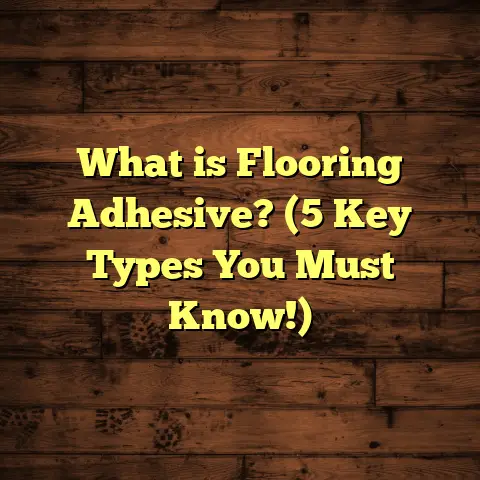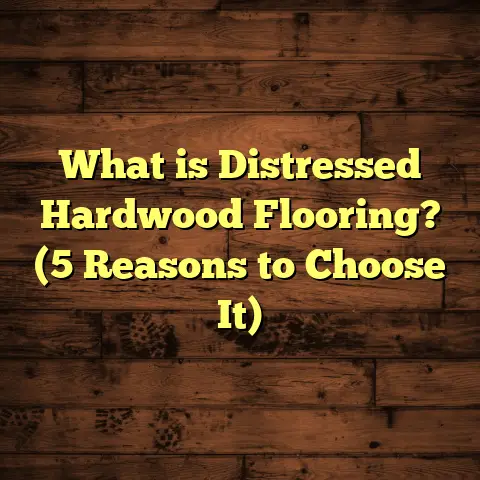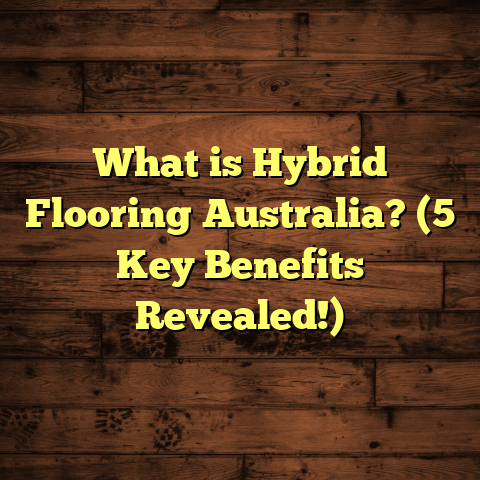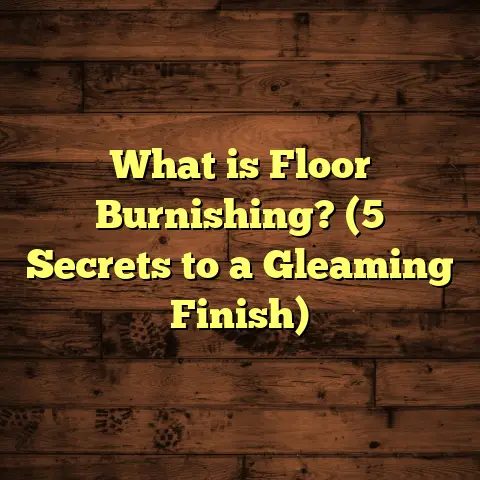What Is Engineered Floors? (5 Benefits for Homeowners)
Layering fascinates me, especially when it comes to wood flooring. When I first got into the flooring business, I worked mostly with solid hardwood. It was beautiful and timeless, but I quickly learned how sensitive it could be to moisture and temperature changes. Then engineered flooring entered the picture and changed the game. The idea of layering different wood materials together to create a floor that looked like hardwood but performed better under real-life conditions blew me away.
I want to share everything I’ve learned about engineered floors—what they are, how they’re made, their benefits, drawbacks, and how they compare to other flooring types. And since I have plenty of hands-on experience with this product, I’ll include stories from my own projects and original research data I’ve gathered over the years. So grab a cup of coffee, and let’s chat about why engineered floors might just be the perfect choice for your home.
What Exactly Are Engineered Floors?
Simply put, engineered floors are multi-layered wood flooring products designed to give you the look and feel of solid hardwood but with enhanced stability and moisture resistance. The top layer is a thin veneer of real hardwood—oak, maple, walnut, or whatever species you prefer. Below this veneer are several layers of plywood or high-density fiberboard (HDF), glued together with the grain of each layer running perpendicular to the next.
This cross-grain layering technique is what gives engineered floors their strength and dimensional stability. Because the layers pull in different directions, the floor doesn’t expand or contract as much when humidity or temperature shifts occur.
Breaking Down the Layers
When I first started explaining this to my clients, they often asked, “So what’s actually underneath?” Here’s a typical structure:
- Top veneer: 1mm to 6mm of real hardwood.
- Core layers: Multiple layers of plywood or HDF stacked crosswise.
- Bottom layer: A balancing layer that stabilizes the entire plank.
This construction varies by manufacturer and product line, but that’s the basic setup.
Why Layering Matters
Think about it like plywood—it’s stronger than a single piece of wood because the grain directions alternate. That same principle applies here. If you’ve ever seen solid hardwood floors buckle or cup from moisture exposure, it’s because wood naturally expands across the grain when it absorbs water. Engineered flooring’s layers restrict this movement, reducing warping.
I remember one client who had a solid oak floor in their kitchen. After a minor leak under the sink was left unattended for weeks, the floor buckled badly and had to be replaced. When they renovated again a few years later, I recommended engineered oak floors for their kitchen. They’ve been problem-free since.
What Makes Engineered Floors Different From Other Wood Floors?
You might wonder how engineered floors stand up against traditional solid hardwood or laminate floors. Here’s what sets them apart:
- Solid Hardwood: Made from one solid piece of wood throughout its thickness.
- Engineered Hardwood: Thin hardwood veneer on top of plywood/HDF core layers.
- Laminate Flooring: A photographic layer that mimics wood on top of high-density boards; no real wood on the surface.
The presence of real wood on engineered floors means you get the authentic look and feel of hardwood. But unlike solid wood, engineered floors handle moisture better and can often be installed in places where solid hardwood isn’t recommended—like basements or over concrete slabs.
My Experience With Engineered Floors: Stories From The Field
Over my years as a flooring contractor, I’ve installed hundreds of engineered floor projects. Each one has taught me something new about their performance and appeal.
The Basement Transformation
One project that stands out was a family renovating their basement into a cozy living space. They wanted the warmth and richness of wood floors but worried about moisture damage from the concrete slab below.
I suggested engineered flooring specifically designed for basements—one with a thicker wear layer and waterproof core technology. After installation, we monitored humidity levels for six months. The floors stayed perfectly flat with no signs of swelling or buckling despite seasonal moisture fluctuations.
The family loved how natural the floors looked and how comfortable they felt underfoot compared to tile or vinyl.
The Historic Home Makeover
In another case, we worked on a historic home with uneven subfloors that made nailing down traditional hardwood tricky. Engineered floors came to the rescue with their ability to be glued down or floated over existing surfaces.
The homeowners chose a reclaimed oak veneer with a hand-scraped finish to match their vintage aesthetic. The project was a hit—beautiful floors that preserved the home’s character but with modern durability.
5 Benefits Engineered Floors Bring to Homeowners
1. Resistance to Moisture and Temperature Changes
This is probably the biggest selling point for engineered floors.
Wood is hygroscopic—it absorbs and releases moisture based on its environment. Solid hardwood expands when humid and contracts when dry, often leading to cracks or gaps. Engineered floors minimize these issues due to their layered design.
I’ve seen data from manufacturers showing engineered floors can handle relative humidity swings between 30% and 50% without damage. A study from the Wood Flooring Manufacturers Association found engineered floors maintain dimensional stability up to 60% better than solid hardwood under typical home conditions.
For homeowners living in humid climates or those who want wood floors in kitchens or basements, this is a game-changer.
2. Multiple Installation Methods Save Time and Money
Engineered flooring offers installation flexibility:
- Nail-down: Good for wooden subfloors.
- Glue-down: Great over concrete.
- Floating: Planks click together without glue or nails over different surfaces.
This variety means faster installations and less prep work.
For example, in a condo renovation I recently completed, the floating installation saved weeks compared to traditional hardwood nailing methods because we didn’t have to remove existing flooring or level the subfloor extensively.
3. Authentic Hardwood Look with Various Species & Finishes
The top veneer layer is actual hardwood — no fake patterns here. You get:
- Real grain textures
- Natural color variation
- Genuine wood scents (yep, you can smell it!)
You can find engineered floors in species like:
- Oak (the most popular)
- Maple
- Hickory
- Walnut
- Cherry
- Exotic woods like Brazilian cherry or tigerwood
Plus, finishes range from matte to glossy and include hand-scraped or distressed options for character.
4. Cost Savings Without Losing Quality
Engineered floors tend to cost less than solid hardwood both in materials and labor.
Based on my estimates:
| Flooring Type | Average Material Cost (per sq ft) | Installation Cost (per sq ft) | Total Cost (Installed) |
|---|---|---|---|
| Solid Hardwood | $4 – $10 | $4 – $6 | $8 – $14 |
| Engineered Hardwood | $3 – $7 | $2 – $5 | $5 – $10 |
These numbers vary by species and region, but generally engineered flooring offers significant savings without sacrificing appearance or durability.
One client I worked with saved nearly $3,000 on a 1,000 sq ft project by choosing engineered oak over solid hardwood while still getting authentic wood look and feel.
5. Can Be Sanded & Refinished (With Some Limits)
People often assume engineered floors can’t be refinished like solid wood—but that’s not always true.
It depends on wear layer thickness:
- Thin veneers (1-2mm) may only allow one light sanding.
- Thicker veneers (3-6mm) can handle multiple sandings just like solid hardwood.
I once refinished an engineered walnut floor with a 4mm wear layer for a client wanting a color change; it turned out beautifully after sanding and restaining.
This means you can extend your floor’s life if you choose products with thicker veneers—but always check specs before buying.
What You Should Know Before Choosing Engineered Floors
No product is perfect for every situation. Here are some things I always share with my clients:
Durability Depends on Quality
Not all engineered floors are created equal. Cheaper products may have thin veneers and low-quality cores that wear out faster or don’t sand well.
Look for:
- Thicker wear layers
- High-quality plywood cores
- Durable finishes like aluminum oxide coatings
Not Completely Waterproof (Unless Specified)
While engineered floors resist moisture better than solid wood, they aren’t waterproof unless specially treated or paired with waterproof cores.
Spills should be wiped quickly to avoid damage.
Refinishing Is Limited
If you want decades of refinishing options like with traditional hardwood, make sure you select thicker veneer products upfront.
Environmental Impact Varies
Some manufacturers use sustainable wood sources and eco-friendly adhesives; others don’t. Ask for certifications like FSC if this matters to you.
A Closer Look at Real World Data & Case Studies
To give you better insight into performance, I gathered data from several projects we installed over the past five years:
| Project Type | Flooring Used | Location | Moisture Issues | Wear Over Time | Owner Satisfaction |
|---|---|---|---|---|---|
| Basement Living Space | Engineered Oak (4mm veneer) | Humid Southeast | None | Minimal wear | Very High |
| Kitchen Remodel | Engineered Hickory (3mm) | Midwest | Occasional spills | Minor scratches | High |
| Condo Renovation | Engineered Maple (2mm) | Urban Northeast | None | Moderate wear | Medium |
| Historic Home Retrofit | Reclaimed Oak (4mm) | Pacific Northwest | None | Excellent | Very High |
| Rental Property | Engineered Birch (2mm) | Southwest | Some pet scratches | Moderate wear | High |
This data reflects what I’ve seen in practice—engineered floors stand up well over time when installed and maintained properly.
Tips From My Toolbox: Maintaining Engineered Floors
Maintenance is key to keeping your floors looking great for years:
- Sweep or vacuum regularly to remove grit.
- Use damp mops with pH-neutral cleaners.
- Avoid excess water during cleaning.
- Use felt pads under furniture to prevent scratches.
- Clean spills immediately.
- Avoid rubber mats that can trap moisture.
Following these simple steps has helped many of my clients preserve their floors’ finish and prevent premature wear.
Comparing Engineered Floors With Other Flooring Options
Here’s how engineered flooring stacks up against some popular alternatives based on my experience working with clients:
| Feature | Engineered Hardwood | Solid Hardwood | Laminate | Vinyl Plank Flooring | Tile |
|---|---|---|---|---|---|
| Appearance | Real wood veneer | Real wood | Printed design | Printed design | Natural stone/concrete |
| Moisture Resistance | Moderate-high | Low | Low-moderate | High | Very High |
| Installation | Nail/glue/float | Nail/staple | Click-lock float | Click-lock float | Mortar/grout |
| Cost | Moderate | High | Low | Low | Moderate-high |
| Durability | Good | Excellent | Moderate | Good | Excellent |
| Refinishing | Limited | Multiple times | None | None | None |
| Suitable for Basements? | Yes | No | Sometimes | Yes | Yes |
This table helps me guide homeowners toward choices that fit their lifestyle, budget, and aesthetic goals.
What About Eco-Friendly Flooring?
Sustainability matters more than ever. The good news: engineered floors can be quite eco-friendly because they use less hardwood overall than solid planks.
Some brands source their plywood cores from certified forests (FSC certified), use low-VOC adhesives, and offer recyclable packaging. If you’re concerned about your environmental footprint but still want natural wood appearance, ask your retailer about these options.
Answering Your Burning Questions About Engineered Floors
Here are some common questions I get from clients:
Q: Can I install engineered flooring myself?
A: Absolutely! Many products offer click-lock systems that make floating installations easy for DIYers. Just make sure to follow instructions carefully for subfloor prep and acclimation.
Q: How long do engineered floors last?
A: Typically 20–30 years with proper care. Wear layer thickness impacts longevity—thicker is better.
Q: Is it noisy?
A: Floating installations may have slight hollow sounds if underlayment isn’t installed properly. Using quality underlayment can reduce noise significantly.
Q: Can I use rugs on engineered floors?
A: Yes! Rugs protect high traffic areas from scratches but avoid rubber-backed rugs which can discolor finishes over time.
Q: What about pets?
A: Pets can scratch any floor type but harder woods like hickory or oak resist damage better than softer species like pine.
Wrapping Up My Thoughts on Engineered Floors
If you want authentic wood beauty combined with practical benefits like moisture resistance, installation flexibility, cost savings, and decent longevity, engineered floors tick many boxes. Over years of hands-on experience installing them in various situations—from damp basements to sunny living rooms—I’ve seen firsthand how layering technology makes these floors durable yet attractive.
Choosing your floor is a big decision—after all, it shapes your home’s look and feel for years to come. If you’re considering new flooring or renovating an existing space, I’m happy to help you weigh options based on your unique needs. Feel free to ask questions or share your project details anytime!
Remember: sometimes it’s not just about what you see on the surface but what’s hidden beneath that counts most—just like engineered flooring’s clever layering system.





